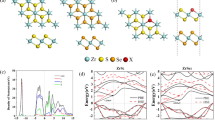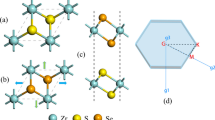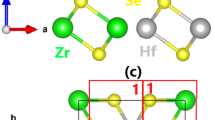Abstract
Context
Two-dimensional semiconductor materials have received much attention in recent years due to their wide variety of applications in the field of nano-optoelectronic devices. In this project, we applied stresses ranging from −6 to +6% to the ZrSe2/HfSe2 heterostructure and systematically investigated its electrical and optical properties. It is discovered that stress can effectively modulate the forbidden bandwidth of the ZrSe2/HfSe2 heterojunction; whereas, under compressive stress, the forbidden bandwidth of the material decreases further until the bandgap is zero, leading to the material’s transformation from semiconductor to metal. The forbidden band gap of the ZrSe2/HfSe2 heterojunction increases with increasing horizontal biaxial tensile strain. We discovered that the light absorption performance of this heterostructure is significantly better than that of its similar monomolecular layer and that its light absorption intensity can reach an order of magnitude of 104. Under compressive and tensile stresses, the ZrSe2/HfSe2 heterojunctions exhibit different degrees of red or blue shift. The results indicate that constructing ZrSe2/HfSe2 heterojunctions and applying horizontal biaxial stresses to them can significantly modulate the optoelectronic properties of the materials. ZrSe2/HfSe2 heterojunction is a new type of high-performance photogenerated carrier transport device with a wide range of applications.
Methods
The calculations in this study are carried out the first principles approach of density functional theory, as implemented in the CASTEP module of Materials-Studio2019. The researchers used an ultrasoft reaction potential to calculate the interactions between the ion core and the electrons and applied the Perdew-Burke-Ernzerhof (PBE) and the generalized gradient approximation (GGA) to perform the calculations. The Monkhorst-Pack technique was employed to create the k-point samples utilized for integration on the Brillouin zone, and the k-point grid was uniformly 6 × 6 × 1. In addition, in order to avoid interactions between the atomic layers affecting the properties and stability of the material, such interactions were prevented by adding a 30 Å vacuum layer. Using a plane-wave energy cutoff of 500 eV and the convergence accuracy of the iterative process was set to 1 × 10−5 eV to ensure the accuracy of the computational results, and in addition. The maximum stress in the lattice was limited to less than 0.05 GPa or the interaction force between neighboring atoms was lower than 0.03 eV/Å. For the calculation of the properties of the optical properties, a k-point grid of 18 × 18 × 1 is used for optimization, and the polarization direction of the material is not taken into account, considering that the material is isotropic. This study proposes to apply the Tkatchenko-Scheffler (TS) dispersion correction method in DFT-D to appropriately represent the interlayer van der Waals interaction forces to solve inaccuracies in the computation of van der Waals interactions via density functional theory.









Similar content being viewed by others
References
Schwierz F (2010) Graphene transistors. Nat Nanotechnol 5:487–496
Geim AK, Novoselov KS (2007) The rise of graphene. Nat Mater 6:183–191
Wei L, Liu G-L, Fan D-Z, Zhang G-Y (2018) Density functional theory study on the electronic structure and optical properties of S absorbed graphene. Phys B Condens Matter 545:99–106
Coleman JN, Lotya M, O’Neill A, Bergin SD, King PJ, Khan U, Young K, Gaucher A, De S, Smith RJ (2011) Two-dimensional nanosheets produced by liquid exfoliation of layered materials. Science 331:568–571
Bafekry A, Faraji M, Karbasizadeh S, Sarsari IA, Jappor H, Ghergherehchi M, Gogova D (2021) Two-dimensional FeTe2 and predicted Janus FeXS (X: Te and Se) monolayers with intrinsic half-metallic character: tunable electronic and magnetic properties via strain and electric field. Phys Chem Chem Phys 23:24336–24343
Bafekry A, Naseri M, Faraji M, Fadlallah M, Hoat D, Jappor H, Ghergherehchi M, Gogova D, Afarideh H (2022) Theoretical prediction of two-dimensional BC2X (X= N, P, As) monolayers: ab initio investigations. Sci Rep 12:22269
Bafekry A, Fadlallah M, Faraji M, Shafique A, Jappor H, Sarsari IA, Ang YS, Ghergherehchi M (2022) Two-dimensional penta-like PdPSe with a puckered pentagonal structure: a first-principles study. Phys Chem Chem Phys 24:9990–9997
Moustafa M, Zandt T, Janowitz C, Manzke R (2009) Growth and band gap determination of the ZrSxSe2− x single crystal series. Phys Rev B 80:035206
Lin L, Liu K, Pang D, Hu C, Deng C, Chen Z, Zhang Z (2023) Effects of V and Mo dopants on electronic structures, magnetic and optical properties of ZrSe2: First-principles calculations. Phys B Condens Matter 655:414733
Habib H, Zhao W, Mir S, Ma L, Tian G (2023) Strongly enhanced infrared absorption of HfSe2 monolayer by lanthanide doping: a first-principles study. Results Phys 48:106415
Yin L, Xu K, Wen Y, Wang Z (2016) Ultrafast and ultrasensitive phototransistors based on few-layered HfSe2. Appl Phys Lett 109:21
Xiang H, Xu B, Zhao W, Xia Y, Yin J, Zhang X, Liu Z (2019) The magnetism of 1T-MX2 (M= Zr, Hf; X= S, Se) monolayers by hole doping. RSC Adv 9:13561–13566
Almayyali AOM, Jappor HR (2023) Prediction of new 2D Hf2Br2N2 monolayer as a promising candidate for photovoltaic applications. Mater Chem Phys 294:126979
Almayyali AOM, Jappor HR, Muhsen HO (2023) High hydrogen production in two-dimensional GaTe/ZnI2 type-II heterostructure for water splitting. J Phys Chem Solids 178:111317
Novoselov K, Mishchenko A, Carvalho A, Castro Neto A (2016) 2D materials and van der Waals heterostructures. Science 353:aac9439
Geim AK, Grigorieva IV (2013) van der Waals heterostructures. Nature 499:419–425
Yousaf M, Younis M, Jbara AS, Khan MJI, Murtaza G, Saeed M (2022) Effect of layer sliding on the interfacial electronic properties of intercalated silicene/indium selenide van der Waals heterostructure. Commun Theor Phys 74:035701
Younis M, Akhter T, Yousaf M, Munir J, Naeem H, Ali M (2023) Layer-sliding-mediated reversible tuning of interfacial electronic and optical properties of intercalated ZrO2/MoS2 van der Waals heterostructure. J Mater Res 1:13
Yousaf M, Munir J, Saeed M, Murtaza G (2018) Layer-sliding-mediated controlled tuning of physical properties of intercalated silicene/hBN heterostructure. Mater Res Exp 6:035005
Palepu J, Anand PP, Parshi P, Jain V, Tiwari A, Bhattacharya S, Chakraborty S, Kanungo S (2022) Comparative analysis of strain engineering on the electronic properties of homogenous and heterostructure bilayers of MoX2 (X= S, Se, Te). Micro Nanostructures 168:207334
Li S, Sun M, Chou J-P, Wei J, Xing H, Hu A (2018) First-principles calculations of the electronic properties of SiC-based bilayer and trilayer heterostructures. Phys Chem Chem Phys 20:24726–24734
Zhang Y, Gu Z, Li T, Li H, Ju W (2022) Study of band alignment type in Janus HfSe2/Ga2SeS and HfSeS/GaSe heterostructures. Comput Mater Sci 209:111432
Kresse G, Furthmüller J (1996) Efficiency of ab-initio total energy calculations for metals and semiconductors using a plane-wave basis set. Comput Mater Sci 6:15–50
Ju W, Zhang Y, Li T, Wang D, Zhao E, Hu G, Xu Y, Li H (2021) A type-II WSe2/HfSe2 van der Waals heterostructure with adjustable electronic and optical properties. Results Phys 25:104250
Zhang Z, Xie Z, Liu J, Tian Y, Zhang Y, Wei X, Guo T, Ni L, Fan J, Weng Y (2020) Band alignment control in a blue phosphorus/C2N van der Waals heterojunction using an electric field. Phys Chem Chem Phys 22:5873–5881
Xia C, Du J, Xiong W, Jia Y, Wei Z, Li J (2017) A type-II GeSe/SnS heterobilayer with a suitable direct gap, superior optical absorption and broad spectrum for photovoltaic applications. J Mater Chem A 5:13400–13410
Lv H, Lu W, Shao D, Lu H, Sun Y (2016) Strain-induced enhancement in the thermoelectric performance of a ZrS2 monolayer. J Mater Chem C 4:4538–4545
Chen D, Lei X, Wang Y, Zhong S, Liu G, Xu B, Ouyang C (2019) Tunable electronic structures in BP/MoSSe van der Waals heterostructures by external electric field and strain. Appl Surf Sci 497:143809
Perdew JP, Burke K, Ernzerhof M (1996) Generalized gradient approximation made simple. Phys Rev Lett 77:3865
Wang X, Du J, Wei S (2017) Impurity characteristics of group V and VII element-doped two-dimensional ZrSe2 monolayer. Physica E Low Dimens Syst Nanostruct 93:279–283
Lebègue S, Björkman T, Klintenberg M, Nieminen RM, Eriksson O (2013) Two-dimensional materials from data filtering and ab initio calculations. Phys Rev X 3:031002
Zhuang HL, Hennig RG (2013) Computational search for single-layer transition-metal dichalcogenide photocatalysts. J Phys Chem C 117:20440–20445
Zhang W, Huang Z, Zhang W, Li Y (2014) Two-dimensional semiconductors with possible high room temperature mobility. Nano Res 7:1731–1737
Rahman A, Kim HJ, Noor-A-Alam M, Shin Y-H (2019) A theoretical study on tuning band gaps of monolayer and bilayer SnS2 and SnSe2 under external stimuli. Curr Appl Phys 19:709–714
Kang J, Tongay S, Zhou J, Li J, Wu J (2013) Band offsets and heterostructures of two-dimensional semiconductors. Appl Phys Lett 102:1
Zhang J-M, Gao X-Y, Wei X-M, Huang Y-H, Ali A, Shahid I (2022) Tailoring the electronic and optical properties of ZrS2/ZrSe2 vdW heterostructure by strain engineering. Thin Solid Films 755:139332
Song H-Y, Sun J-J, Li M (2021) Enhancement of monolayer HfSe2 thermoelectric performance by strain engineering: a DFT calculation. Chem Phys Lett 784:139109
Van On V, Thuy HTP, Van Ngoc H, Guerrero-Sanchez J, Hoat D (2023) ZrSe2-HfSe2 lateral heterostructures: stability, fundamental properties, and interline defects. Appl Phys A 129:259
Jiang B, Peng X, Qu Y, Wang H, Tian C, Pan Q, Li M, Zhou W, Fu H (2014) A new combustion route to synthesize mixed valence vanadium oxide heterojunction composites as visible-light-driven photocatalysts. ChemCatChem 6:2553–2559
Yang L, Cui X, Zhang J, Wang K, Shen M, Zeng S, Dayeh SA, Feng L, Xiang B (2014) Lattice strain effects on the optical properties of MoS2 nanosheets. Sci Rep 4:5649
Wang D, Yang L, Cao J (2021) Thermal properties of monolayer MoS2 and WS2/MoS2 heterojunction under three strain states. Chem Phys 549:111260
Xing H-Y, Zheng Z-J, Zhang Z-H, Wu W-J, Guo Z-Y (2021) Tunable electronic structure and optical properties of BlueP/XTe2(X=Mo,W) van der Waals heterostructures by strain. Acta Phys Sin 70:6
Huang L, Li Y, Wei Z, Li J (2015) Strain induced piezoelectric effect in black phosphorus and MoS2 van der Waals heterostructure. Sci Rep 5:16448
Zemzemi M, Elghoul N, Khirouni K, Alaya S (2014) First-principle study of the structural, electronic, and thermodynamic properties of cuprous oxide under pressure. J Exp Theor Phys 118:235–241
Zhang M, Zhao S, Lu Q (2018) Enhanced photocatalytic performance of silver–based solid solution heterojunctions prepared by hydrothermal method. Mater Sci Semicond Process 85:52–58
Wang K, Xiao Q, Xie Q, Wang L, He T, Chen H, Shi J (2019) First-principles study of electronic structure and optical properties of La-Doped AlN. J Electron Mater 48:5135–5142
Tse G, Yu D (2015) The first principle study: electronic and optical properties in Bi2Se3. Comput Condens Matter 4:59–63
Li F-Y, Yang Z-X, Cheng X, Zeng L-Y, Ouyang F-P (2021) First-principles study of electronic structure and optical properties of monolayer defective tellurene. Acta Phys Sin 70:16
He J, Wei X, Jia Y, Liu J, Tian Y, Zhang Y, Fan J, Guo T, Ni L, Duan L (2021) A first-principles research of two-dimensional AlN/C2N van der Waals heterostructure as photocatalyst. Physica E Low Dimens Syst Nanostruct 132:114754
Chen P, Zhang L, Wang R, Shang J, Zhang S (2019) Electronic and optical properties of the ZrS2/HfSe2 van der Waals heterobilayer with native type-II band alignment. Chem Phys Lett 734:136703
Funding
Foundation: National Natural Science Foundation of China (Approval No. 11102118); Liaoning Province “Millions of Talents Project” Fund (Approval No. 100010131).
Author information
Authors and Affiliations
Corresponding author
Ethics declarations
Competing interests
The authors declare that they have no competing interests.
Additional information
Publisher’s Note
Springer Nature remains neutral with regard to jurisdictional claims in published maps and institutional affiliations.
Rights and permissions
Springer Nature or its licensor (e.g. a society or other partner) holds exclusive rights to this article under a publishing agreement with the author(s) or other rightsholder(s); author self-archiving of the accepted manuscript version of this article is solely governed by the terms of such publishing agreement and applicable law.
About this article
Cite this article
Wei, X., Yang, L., Sun, S. et al. Strain-induced effects on the optoelectronic properties of ZrSe2/HfSe2 heterostructures. J Mol Model 30, 3 (2024). https://doi.org/10.1007/s00894-023-05793-0
Received:
Accepted:
Published:
DOI: https://doi.org/10.1007/s00894-023-05793-0




